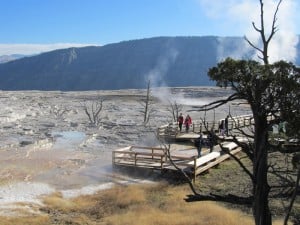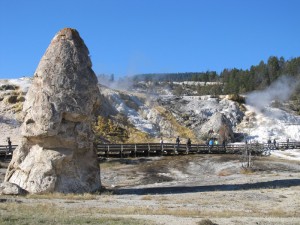 The North entrance to Yellowstone National Park is open year-round, and leads to the magnificent Mammoth Hot Springs area located about five miles inside the park. Most visitors think of Old Faithful as the primary “hot spot” in Yellowstone, but the upper and lower travertine terraces at Mammoth are not to be missed. These numerous hydrothermal features are constantly changing and active, so there’s no waiting for just one big geyser to put on a show. If you visit in winter, not only is the Mammoth Hot Springs Hotel open year round, but so is Mammoth Campground. Most of the RV sites here are pull-throughs.
The North entrance to Yellowstone National Park is open year-round, and leads to the magnificent Mammoth Hot Springs area located about five miles inside the park. Most visitors think of Old Faithful as the primary “hot spot” in Yellowstone, but the upper and lower travertine terraces at Mammoth are not to be missed. These numerous hydrothermal features are constantly changing and active, so there’s no waiting for just one big geyser to put on a show. If you visit in winter, not only is the Mammoth Hot Springs Hotel open year round, but so is Mammoth Campground. Most of the RV sites here are pull-throughs.
 At Mammoth, a network of fractures and fissures in the earth allow water that has collected underground to reach the surface. The water comes from rain and snow and is heated by a volcanic magma chamber deep underground. The hot water flows over limestone (deposited here millions of years ago when it was a vast sea) on its way to the surface, creating a weak carbonic acid. This acid water dissolves calcium carbonate in the limestone and is deposited in the form of travertine, the rock that forms the white terraces of Mammoth Hot Springs. Thermophiles (heat-loving organisms) create the colors you see where hot water flows over the terraces. Colorless and yellow thermophiles grow in the hottest water; orange, brown, and green thermophiles thrive in cooler water. Colors change with the seasons.
At Mammoth, a network of fractures and fissures in the earth allow water that has collected underground to reach the surface. The water comes from rain and snow and is heated by a volcanic magma chamber deep underground. The hot water flows over limestone (deposited here millions of years ago when it was a vast sea) on its way to the surface, creating a weak carbonic acid. This acid water dissolves calcium carbonate in the limestone and is deposited in the form of travertine, the rock that forms the white terraces of Mammoth Hot Springs. Thermophiles (heat-loving organisms) create the colors you see where hot water flows over the terraces. Colorless and yellow thermophiles grow in the hottest water; orange, brown, and green thermophiles thrive in cooler water. Colors change with the seasons.
 A series of boardwalks and overlooks allow you to easily view the terraces. Some of these are flat enough for wheelchairs, but others leading to the upper terraces are steep and have lots of stairs. There’s also a narrow and winding one-way 1.5-mile drive, but trailers and motor homes are prohibited from this roadway. The views are actually the best from the boardwalks and overlooks, so park and explore on foot instead. Pick up a trail guide and read the interpretive signs along the boardwalks to get the most from your visit. In addition to terraces, you’ll see a myriad of colorful springs (some very active, others almost dry), tree skeletons, and mounded mineral deposits such a Liberty Cap. This 37-foot formation was named in 1871 for the peaked knit caps symbolizing freedom and liberty that were worn during the French Revolution. The park service is very strict about preserving all of these fragile and rare hydrothermal features, so please stay on the paths, and don’t eat, smoke, bring pets, or drop any objects into the water.
A series of boardwalks and overlooks allow you to easily view the terraces. Some of these are flat enough for wheelchairs, but others leading to the upper terraces are steep and have lots of stairs. There’s also a narrow and winding one-way 1.5-mile drive, but trailers and motor homes are prohibited from this roadway. The views are actually the best from the boardwalks and overlooks, so park and explore on foot instead. Pick up a trail guide and read the interpretive signs along the boardwalks to get the most from your visit. In addition to terraces, you’ll see a myriad of colorful springs (some very active, others almost dry), tree skeletons, and mounded mineral deposits such a Liberty Cap. This 37-foot formation was named in 1871 for the peaked knit caps symbolizing freedom and liberty that were worn during the French Revolution. The park service is very strict about preserving all of these fragile and rare hydrothermal features, so please stay on the paths, and don’t eat, smoke, bring pets, or drop any objects into the water.
IF YOU GO:
The North Entrance is located in Gardiner, Montana, 50 miles south of Livingston, Montana at Interstate 90. From I-90, take the Livingston, Montana exit for Yellowstone National Park and Highway 89 South. Proceed 50 miles to Gardiner, Montana and the North entrance to Yellowstone. Mammoth Hot Springs is 5 miles south of the North entrance. For more information, visit http://www.nps.gov/yell/index.htm or call 307-344-7381. $25 entrance fee per vehicle, good for 7 days. Camping fees are extra.

Leave a Reply